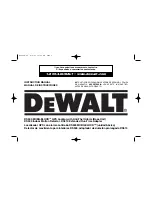
OPERATION, TESTING & MAINTENANCE
OPERATION:
The smoke alarm is operating once the battery is connected. When products of
combustion are sensed, the unit sounds a loud alarm which continues until the air is cleared.
This alarm incorporates the internationally recognized horn signal for evacuation. During alarm
mode, the horn produces three short beeps followed by a two second pause and then repeats.
FALSE ALARMS "Alarm Mute" Feature:
Units with the "Mute" feature have the capability of
temporarily reducing the sensitivity of the alarm circuit for approximately 8 minutes. This feature is to
be used only when a known alarm condition such as smoke from cooking activates the smoke
alarm. The smoke alarm is deactivated by pushing the test button on the smoke alarm cover for at
least three seconds. The smoke alarm will automatically reduce sensitivity and "beep" every 30-40
seconds for approximately 8 minutes to indicate the alarm is in the temporary silent condition. The
smoke alarm will gradually reactivate during the 8 minutes and sound the alarm if particles of
combustion are still present. The "Mute" feature may be used repeatedly until the air has cleared.
CAUTION: Before using the “Alarm Mute" feature, identify the source of smoke and be
certain that safe conditions exist.
TESTING:
Test by pushing the test button on the smoke alarm cover until the alarm sounds, then
release. The alarm sounds if all electronic circuitry, horn and battery are working. The alarm may
continue to sound for up to 10 seconds after the button is released. If no alarm sounds, the unit may
have a defective battery or other failure. Test the smoke alarm weekly to assure proper operation.
Page 4
NEVER use an open flame of any kind to test this unit. You might accidentally damage or set
fire to the unit or to your home. The built-in test switch accurately tests the unit's operation
as required by Underwriters Laboratories Inc. (UL).
If you choose to use an aerosol smoke product to test the smoke alarm, be certain to use one
that has been Listed to Underwriters Laboratories, Inc. Safety Standards and use it only as
directed. Use of non-UL Listed products or improper use of UL Listed products may affect
the smoke alarm's sensitivity.
RV INSTALLATION -
WARNING:
TEST SMOKE ALARM OPERATION AFTER VEHICLE HAS BEEN IN STORAGE,
BEFORE EACH TRIP, AND AT LEAST ONCE PER WEEK DURING USE. An identical marking is
to be provided by the recreational vehicle manufacturer that shall be permanent and located, visibly,
within 24 inches (610mm) of the smoke alarm.
MAINTENANCE:
The smoke alarm is virtually maintenance free. However, under dusty conditions,
a vacuum hose may be used to clear the sensing chamber of dust.
BATTERY REPLACEMENT
The smoke alarm comes with a 9 Volt battery. The battery should last for at least one year
under normal operating conditions. The smoke alarm has a low battery indicator, an audible "beep."
It will operate at 30-40 second intervals for a minimum of 7 days. When this indication occurs,
replace the battery with an Alkaline type (Eveready Energizer #522, Duracell #MN1604.
REPAIRS AND SERVICES
The smoke alarm contains less than 1 microcurie (37 kilobecquerel) of Americium 241, a radioactive
material.
The distribution of these ionization-type smoke alarms is licensed by the U.S. Nuclear
Regulatory Commission; the consumer is exempt from any licensing or requirements.
If the
smoke alarm is defective in any way, do not tamper with the unit. Return the unit for servicing. (See
warranty for instructions or in-warranty returns.) There will be a service charge for repairing out of
warranty units.
























